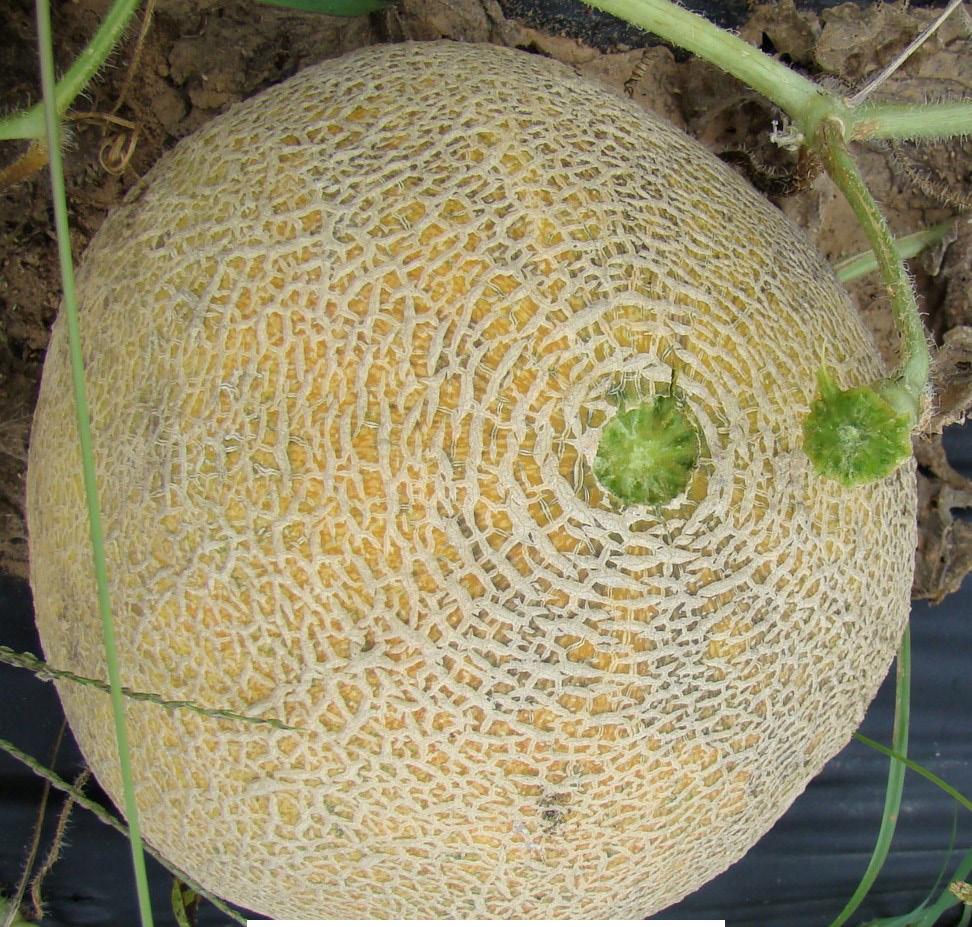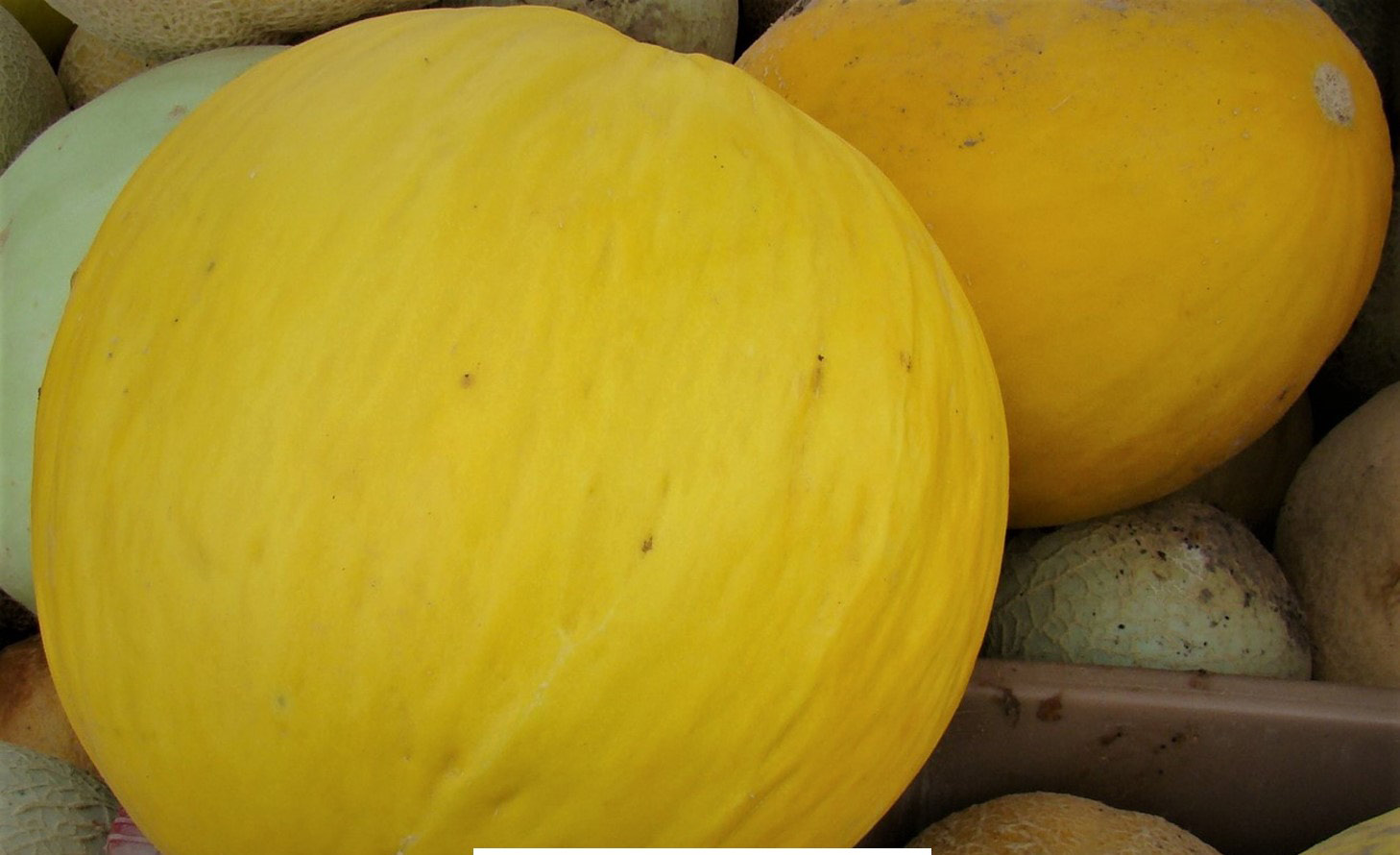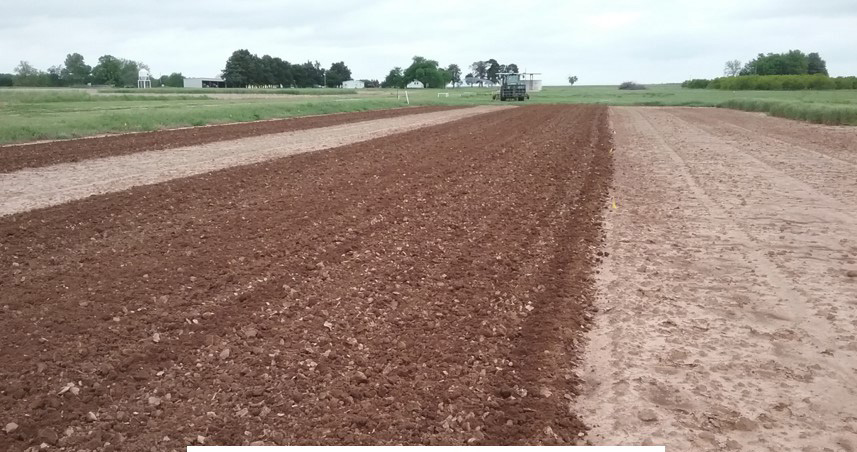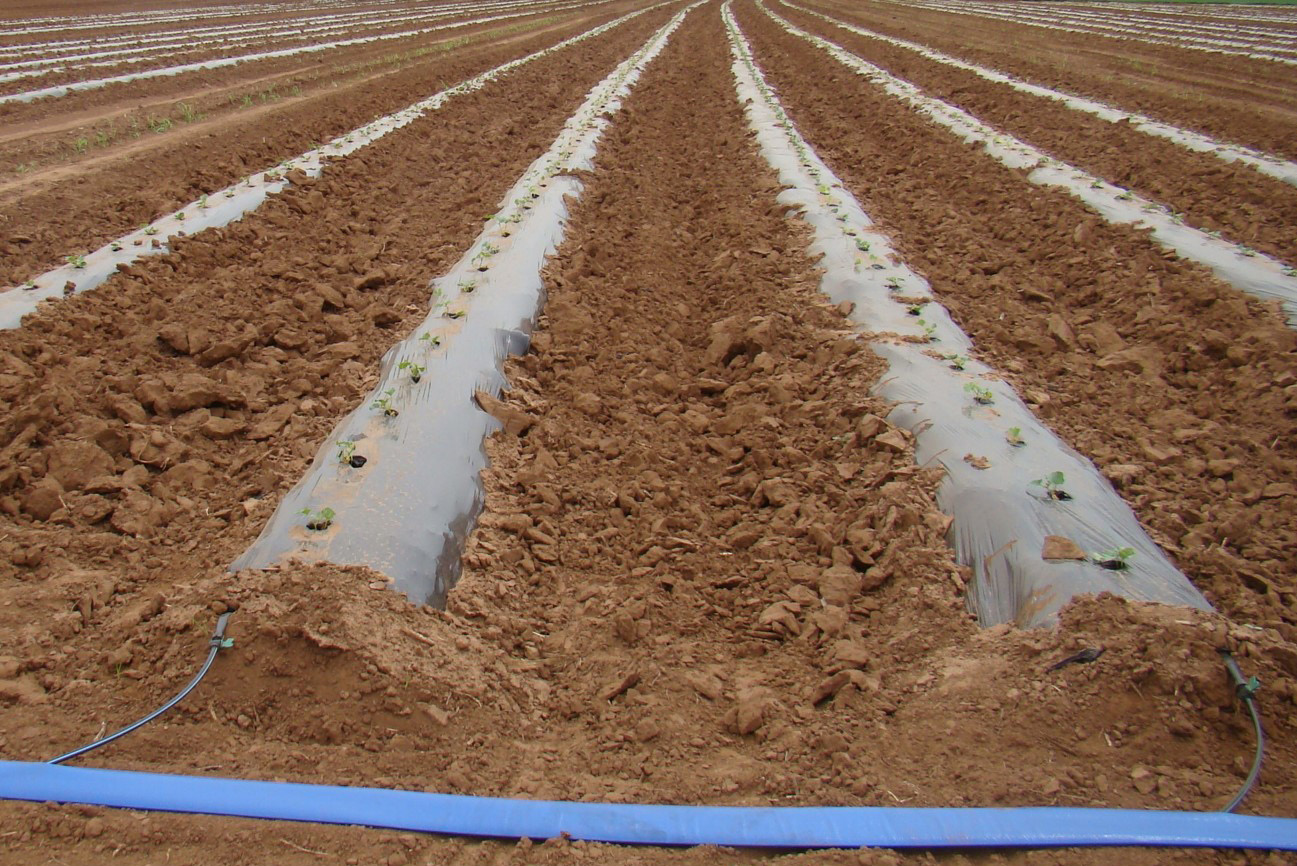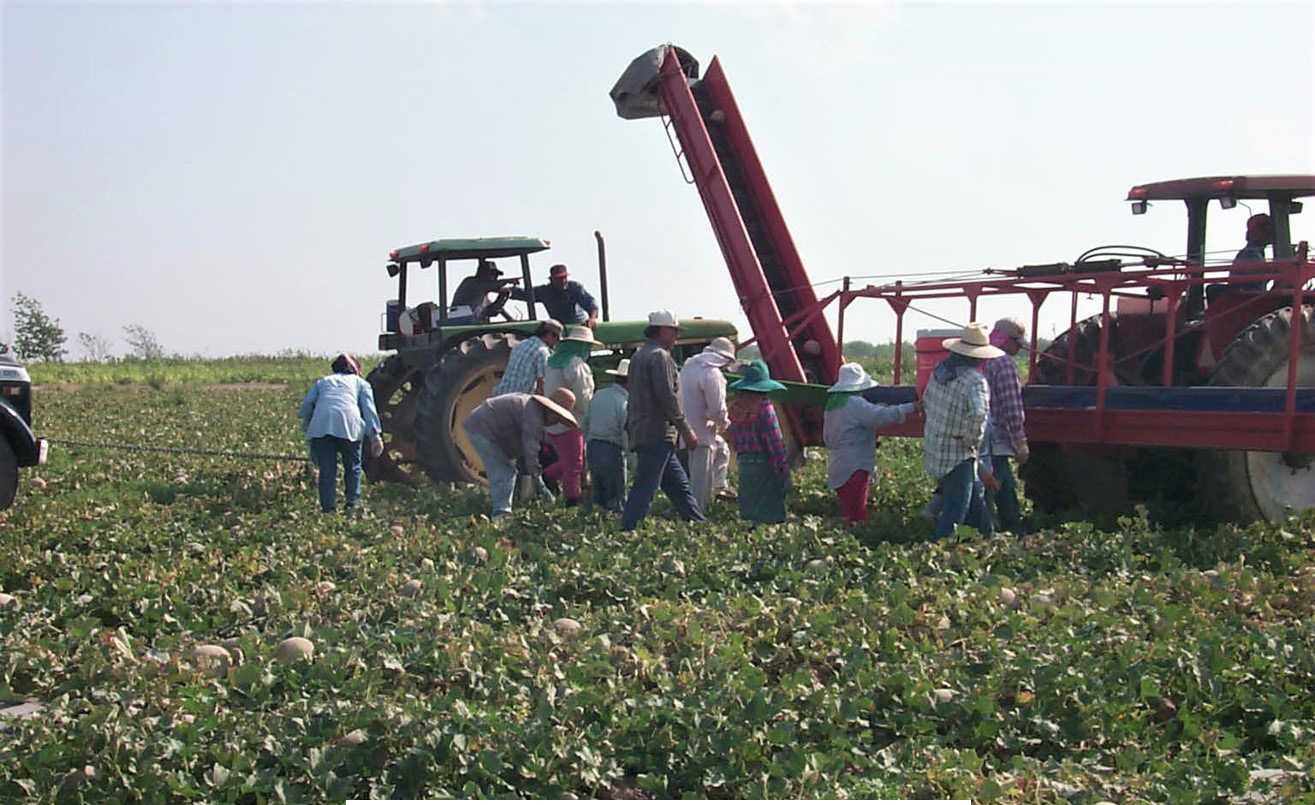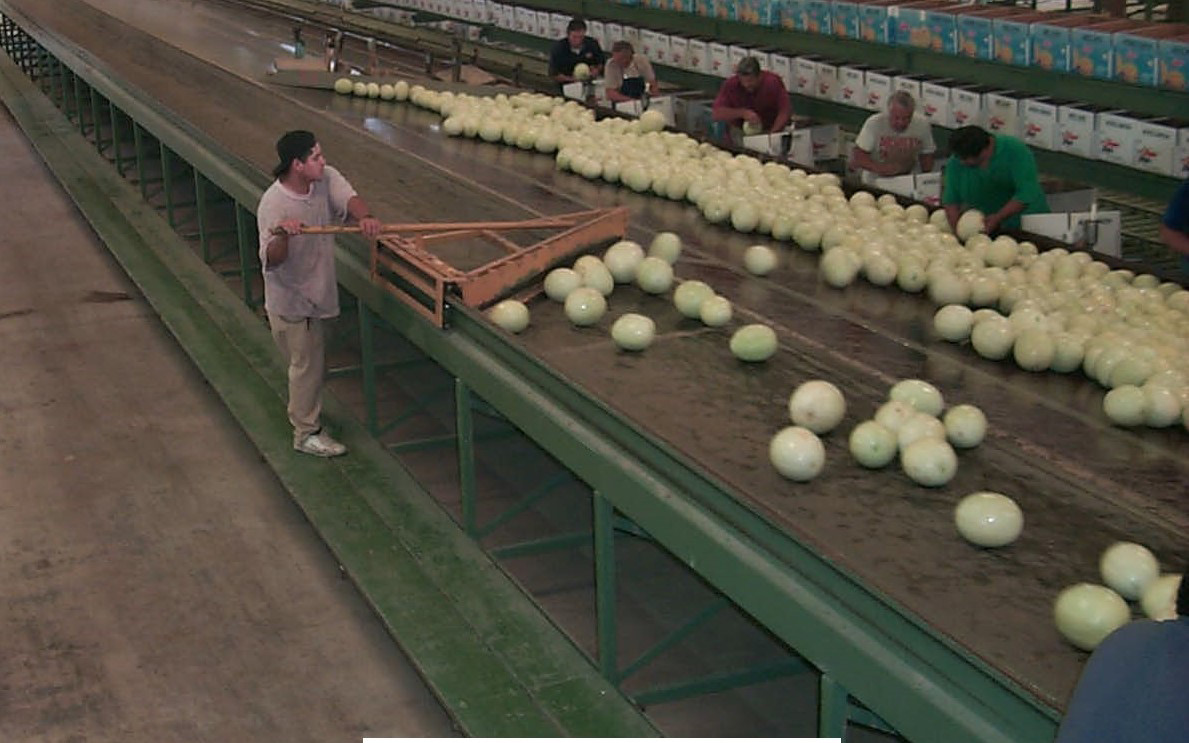Melon Production
- Jump To:
- Origin and Families
- Production Requirements
- Sites and Soils
- Varieties of Muskmelon
- Winter Melon Types and Varieties
- Soil pH and Fertilizer
- Soil Preparation
- Planting and Plant Spacing
- Weed Management
- Irrigation
- Field Scouting for Crop and Pest Development
- Insects
- Diseases
- Pesticide Applications
- Animal Pests
- Harvesting
- Handling and Storage
- Marketing
- References
Origin and Families
Melons belong to the botanic group, Cucumis melo, and are thought to originate in Persia, India and adjacent areas. Melons include muskmelon, honeydew, casaba and crenshaw melons, with muskmelon being the primary melon grown in Oklahoma. There are distinctions made between the different types based upon their botanical classification. Cucumis melois the genus and species for the entire group, but the botanical variety cantaloupensis is the true cantaloupe of which few are grown in the U.S. What is considered a cantaloupe in the U.S. actually comes from the variety group reticulatus (muskmelons) which is the netted aromatic melon that most U.S. consumers of “cantaloupe” are familiar with. Orange-fleshed muskmelon has higher levels of vitamin A than the white-fleshed casaba and crenshaw melons. The variety group inodorous lacks the aromatic flavor muskmelon has. Compared to muskmelon, these are later maturing, have firmer and thicker flesh and can be stored for longer periods. Members of this group of melons are referred to as winter melons and include Casaba (yellow corrugated rind-white flesh), Crenshaw (dull yellow rind-pale orange flesh) and Honeydew (smooth creamy white rind-light green flesh). Other botanical varieties in the melon group include the snake melon (flexuosus), oriental pickling melon (conomon), mango melon and garden lemon (chito) and the Queen Anne’s pocket melon (dudaim) (Peirce, 1987).
Production Requirements
Melons, in particular the winter types, are better adapted to the drier southwestern areas of the state where foliage diseases are less of a problem. Although hot, dry weather is favorable for muskmelon, they can be grown successfully in most areas if diseases can be managed. Muskmelons are not as well adapted to extremely hot summer weather as watermelons and winter melons.
Melon production is limited by high labor requirements for harvesting and difficulty in controlling fungal and virus dis-eases. There is evidence the use of sorghum x Sudan grass or other annual warm-season forage grasses can reduce the level of virus in cucurbit crops when planted as windbreaks between rows of melons.
Good melon yields under irrigation in Oklahoma are 8 tons per acre. With ideal conditions, more than 10 tons per acre have been achieved. Winter melons can exceed the yield of muskmelons with the right conditions.
Flowering is monoicous, meaning there are separate male and female flowers borne on the same plant. What that means for fruit production is that pollen from the male flowers must be transferred onto the stigma of the female flowers. Because this is done primarily by insect pollinators, protecting and managing pollinator insects is critical for fruiting. Better pollination translates to more seeds formed in the fruit, and therefore larger fruit within a given species.
Sites and Soils
Melons grow best on well drained, warm, sandy or silt loam soils, but a variety of soil types can be used. To reduce the risk of diseases and insects, do not plant on land where melons, watermelon, squash, cucumber or pumpkin have been grown during the past three years. Where early harvest is of importance, plant in sandy soils located in good sun exposure with air drainage. If soil drainage is less than optimal, melons will benefit from the formation of free-standing raised soil beds, which also will capture more heat from direct sunlight and help to speed the emergence and development of melon crops. These beds can be formed by using a commercial bed-shaper. Drip irrigation tape can be installed with most bed-shapers during bedding. Melons will produce higher yields if supple-mental irrigation is available during drought conditions, which occur during most summer growing seasons. Nematodes can be a problem and producers should rotate fields to non-host species, such as annual grasses or cereal grains, to reduce the chances of nematode populations increasing.
In wind-prone areas, windbreaks are advisable in sandy soils to reduce “sand blast” damage, breaking and stunting of seedling plants caused by spring winds. Windbreaks can consist of strips of winter cover crop that have been left in the field between every two to three rows of melons, or strips of sorghum x sudan (haygrazer) planted earlier in the spring prior to the establishment of melon crops.
Varieties of Muskmelon
Several varieties of muskmelon and winter melons are grown in Oklahoma. For more information, see OSU Fact Sheet HLA-6035, Commercial Vegetable Varieties for Oklahoma. the shipping market, the smaller heavily netted, broadly oval or round and slightly ribbed varieties of muskmelon are used. The larger, more deeply ribbed and lightly netted varieties are sometimes preferred for short-distance shipping, local markets and roadside stands. Listed below are varieties that have performed well in Oklahoma. Varieties vary greatly in disease resistance. Disease resistance should be considered, particularly to powdery mildew and Fusarium wilt. No varieties have shown insect or nematode resistance.
Muskmelon Varieties
Ambrosia, Athena, Burpee Hybrid, Cruiser, Gold Rush, Imperial 45, Navigator, Super 45, and TAM-Uvald
Figure 1. Muskmelon at full slip.
Winter Melon Types and Varieties
Winter melons are not as well adapted to Oklahoma growing conditions as are muskmelons. Except for some honeydew varieties, winter melons are susceptible to most melon diseases. Winter melon production only should be at-tempted with a careful foliar disease management program. Without a protective spray program against foliar diseases, complete crop loss can result.
Honeydew. The TAM-Dew Improved variety (95 days to harvest) is round and measures about 5 inches in diameter. It is resistant to powdery and downy mildew. Fruit is whitish at maturity and smooth with no ribs. Flesh is lime green.
Casaba. The Golden Beauty variety (105 days to harvest) is globe shaped, pointed at the stem and measures about 8 inches in diameter. Fruit is yellow with corrugations but no netting. Flesh is white, thick, juicy and with a pleasing sweet flavor. It stores well. Golden Beauty is susceptible to diseases, especially powdery mildew.
Crenshaw. The Crenshaw variety (110 days to harvest) is somewhat acorn shaped, pointed at the blossom end and measures 8 inches by 6 ½ inches in diameter. Fruit is yellow and green, rough, corrugated and with no netting. Flesh is salmon colored, thick, juicy and sweet. Crenshaw requires careful handling and packing for shipping. Crenshaw is susceptible to diseases.
Figure 2. Winter melons.
Soil pH and Fertilizer
Melons are tolerant to a wide range of soil pH, but soil with a pH between 6.0 and 6.8 is preferred. If the soil pH is below 5.8, it should be limed to increase the pH to 6.0 or above. Based on OSU soil test results, recommended amounts of phosphorus (P2O5) and potassium (K2O) are given in Table 1.
Nitrogen: The nitrate-N value given by the soil test re-port should be used to determine nitrogen fertilizer needs on a particular soil. Subtract the available nitrogen given in the preplant soil test results from that needed initially by the crop. For example, if the soil test indicates 15 pounds of available nitrogen, subtract that 15 pounds from the pre-plant nitrogen application of 50 pounds, meaning you would need 35 pounds of nitrogen applied prior to planting. On soils with low levels (5 pounds or less) of nitrogen, apply 50 pounds per acre of nitrogen pre-plant incorporated along with recommended P2O5 and K2O (Table 1) prior to planting. An alternate method would be to band all fertilizer with the planter 3 inches to 4 inches below and 2 inches to 3 inches to the side of the seed row. High levels of nitrogen in the soil will cause excessive growth and delayed flowering and fruit set; therefore, do not over-apply nitrogen. Melons will respond to nitrogen fertilizer, so top-dressing (applying fertilizer to the soil surface then cultivating or watering it into the soil) is advised. Melons will respond to nitrogen fertilizer, so top-dressing (applying fertilizer to the soil surface then cultivating or watering it into the soil) is advised. One pre-plant application of nitrogen at 50 pounds per acre should be followed by two supplemental top-dresses of nitrogen. The first supplemental top-dress should include 50 pounds per acre of nitrogen and the second 25 pounds per acre. Time the first top-dress three weeks after seedling emergence and the last three weeks after the first top-dress. These three nitrogen applications should supply ample nitrogen for the crop. Another method of managing nitrogen is to inject it through a drip irrigation system, if it is used for crop watering. The advantage of applying nitrogen through the drip system is that smaller amounts of nitrogen can be applied on a more regular basis, thereby reducing the risk of over-applying nitrogen and reducing nitrogen loss from leaching by heavy rains. In addition, less nitrogen will be available for weedy competitors, since nitrogen applied through the drip system is applied down the row, not broadcast over a wider area. Even if fertilizer is injected through the drip irrigation system, it is wise to make a pre-plant application of nitrogen, phosphorus and potassium based upon soil test recommendations, or apply all of them through the drip irrigation system if a water-soluble complete fertilizer (fertilizer containing N-P-K) is used.
Table 1. Phosphorous and potassium requirements for melon.
| Phosphorous Requirements | (lbs. P2O5/Acre) | ||||
|---|---|---|---|---|---|
| When test shows | 0 | 10 | 20 | 40 | >65 |
| Add lbs. P2O5 | 120 | 100 | 80 | 45 | 0 |
| Potassium Requirements | (lbs. K2O/Acre) | ||||
|---|---|---|---|---|---|
| When test shows | 0 | 75 | 125 | 200 | >250 |
| Add lbs. K2O | 150 | 125 | 100 | 50 | 0 |
Soil Preparation
Conventional clean tillage methods can be used for soil preparation including chisel or moldboard plowing, disking and harrowing. An alternative to tilling the entire field area would be to strip till where a cool-season cover crop strip is left between every two to four rows of melon, allowing for wind-breaks, harvest and spray alleys if spraying is necessary. Melons often are grown on flat soil with no raised bed. With normal conditions, there is no advantage in bedding-up well-drained sandy soil. On low, tighter bottom ground or if wet weather is anticipated, a free-standing raised bed can help protect the crop in the event of untimely wet periods.
Figure 3 and 4. Conventional tillage (top) and strip tillage (bottom).
One potential challenge with conventional clean tillage is the loss of soil organic matter due to the physical cutting-up of organic residues and the increase of soil microbial activity in breaking down organic residues. One solution to this loss of organic matter would be the use of winter cover crops to increase soil organic matter. When a winter legume, such as Austrian winter pea or winter clovers, etc. are included with a cereal grass in the cover crop mix, not only will soil organic matter be increased, but there also will be a gain in available nitrogen for subsequent warm-season crops such as melon.Research has indicated a direct benefit to using cover crops with at least one legume in the cover crop mix in the winter prior to planting a warm-season crop such as melon. In an organic system, legume cover crops are a good source of nitrogen that will be available for an extended period during the growing season.
Planting and Plant Spacing
A key aspect of establishing melons is waiting until the soil temperature at planting depth is at least 60 F (75 F to 95 F optimal germination temperature), otherwise plants will be slow to emerge and crop stands will be variable with plants in various stages of growth. In addition, cold soil temperatures early in the season can result in blossom end rot (BER). Blossom end rot is a physiological condition where calcium is reduced in availability during flowering and fruiting resulting in a brown leathery area on the bottom (blossom end) of the fruit, rendering the fruit unsaleable. Blossom end rot usually occurs on early set fruit and is related to several conditions, with cold soils being a major factor. Black plastic mulch covering the soil surface may help warm the soil faster and reduce the amount of blossom end rot.
Direct seeding is the primary method used for crop establishment. Seed melon approximately ½ inch to ¾ inch deep in rows 60 inches to 84 inches apart. Seeds should be spaced 6 inches to 8 inches apart in the row, then thinned to 12 inches apart.
Transplants of melon also can be used for establishment and will take approximately three weeks to four weeks to produce prior to transplanting in the field (HLA-6020, Growing Vegetable Transplants). Unless the producer is targeting a very early market, transplants aren’t normally used, as the medium-sized seeds will germinate and grow rapidly when soil temperatures are conducive to germination. Transplanting into raised beds covered with black plastic mulch will reduce the time to harvest, particularly during cool, wet springs.
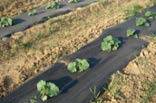
Figure 5. Black plastic mulch and drip irrigation.
Weed Management
Commercial production of melons typically employs either a plastic mulch system or the use of pre- and post-emergence herbicides. Whether conventional clean tillage, strip tillage or mulches are to be used, producers will encounter weed com-petition when producing melons. Weed control will be critical in the early growth stages, while seedlings or transplants are small. Shallow cultivation by tractor-drawn cultivators, hoeing by hand or tillers will be required in the early stages of crop development in an organic system and also may be needed in conventional production. When cultivating, be certain to cultivate at a depth that is shallow, but deep enough to be effective for killing weeds since deep cultivation will damage crop roots and bring more weed seed to the surface. After the crop begins to shade the soil surface, less cultivation will be needed to maintain the field due to the ability of melons to shade the soil surface.
Figure 6. Organic mulch.
Further control of weedy species can be attained through the use of organic mulches once soil temperature has increased and crop growth is rapid. Some organic mulching materials during decomposition can compete directly with the crop for nitrogen, therefore, don’t use mulches with high carbon-to-nitrogen ratios (bark, wood chips and ground wood products). In addition, the need for tillage can be reduced considerably if pre-emergence or post-emergence herbicides are a viable option for the farm. Registered herbicides for melons can be found in E-832, Extension Agents’ Handbook of Insect, Plant Disease, and Weed Control. As with any pesticide, be certain to read and follow label instructions pertaining to what crops it can be used with and how to safely store and use the material.
Irrigation
Adequate moisture is needed by all crops to grow and flourish. Melons require properly managed soil moisture while making their most vigorous growth until the early fruit-set melons are fully sized. Reduce irrigation just before and during the ripening period or sugar content will be reduced and stem-end cracking and fruit rotting may occur. Do not operate an overhead sprinkler irrigation system between sunrise and 11 a.m. during the flowering and fruit-setting period since bees may be prevented from pollinating the open flowers. Otherwise, when overhead sprinkler irrigation is used, water should be applied early in the day (except during pollination) so leaves can dry before nightfall to reduce the incidence of fruit rot and foliar diseases. Although melons are crops that can tolerate both heat and some drought, these crops will not maximize their potential for yield and profitability if they are drought stressed. Irrigation is needed when the crop is not receiving adequate rainfall to meet its needs. If adequate rainfall is lacking, it will be necessary to provide supplemental irrigation totaling 1.5 inches of water every 10 days during the hottest months of the summer.
Water can be delivered to the crop in a number of ways including overhead sprinklers, furrow irrigation and drip irrigation systems. Drip irrigation often is used in situations where there is not adequate water volume or pressure to meet the higher use requirements for overhead systems. Drip systems are a very efficient means of distributing irrigation water, since water is either applied to the surface of the soil or subsurface with buried drip tape. Other benefits to drip irrigation include being able to carry on other field operations during irrigation, not wetting the crop foliage, thereby reducing crop disease pressure and being able to fertilize through the drip system.
Figure 7. Drip irrigation and plastic-covered raised beds.
Field Scouting for Crop and Pest Development
Fields should be scouted at a minimum of once per week after planting by walking across the entire field in a V- or X-shape pattern and recording plant development and weed and insect occurrence and numbers. Results of surveys will be needed to make decisions regarding projection of harvest date, the need to bring in honey bees for pollination and pest control decisions.
If known, scout for diseases in areas of a field in which diseases tend to appear first. Otherwise, use the V- or X-shape sampling pattern outlined for insects. Some foliar diseases will appear where air circulation is reduced and leaves remain wet, such as in low areas and along borders sheltered by trees. Foliar diseases typically appear first on crown leaves close to the base of the main stem. Shaded crown leaves often die and can be mistaken as diseased. Root diseases tend to appear where soil remains wettest, such as in low areas and in heavier soils.
Insects
Fields previously in sod or having heavy infestations of weeds in the prior year should be treated with a soil-applied insecticide at planting to control soil insect pests including cutworms. Small seedlings are extremely susceptible to feeding damage from adult striped and spotted cucumber beetles and may need to be treated with a foliar-applied insecticide to prevent complete defoliation and/or infection by bacterial wilt transmitted by cucumber beetles. Adult cucumber beetles must be controlled in mid-season to prevent them from laying eggs near fruit where larvae can feed and damage the rinds, resulting in unmarketable fruit. Squash bugs must be controlled early in the growing season and can best be located by examining the undersides of leaves for eggs, which are laid in groups. Aphids and mites can cause damage to leaves and leave deposits on fruit, reducing marketable yield. Low numbers can be tolerated throughout most of the season and scouting survey results will indicate whether populations are increasing and should be controlled.
Good fruit set and development are dependent upon insects, primarily honey bees, to pollinate the female flowers. Flowers are receptive to pollination for a matter of hours on the day they open. Flowers should be examined to determine activity of honey bees. If less than one bee per 10 flowers is noted during the morning hours, the producer should bring bee hives into the field to ensure adequate pollination.
Diseases
Cantaloupe is susceptible to several diseases that attack the roots, foliage and fruit. The most common diseases in Oklahoma have been Fusarium wilt, anthracnose, powdery mildew, downy mildew, virus diseases and fruit rots. Bacterial wilt, alternaria leaf spot, gummy stem blight, damping off, root rot/vine decline and root-knot nematode also have been problems. Consult OSU Extension Circular E-929, Guide for Identification and Management of Diseases of Cucurbit Vegetable Crops to help identify these diseases.
Disease control is essential in the production of high-quality cantaloupes. A preventive program that combines the use of cultural practices, genetic resistance and chemical control as needed usually provides the best results.
Cultural practices are useful for limiting the establishment, spread and survival of pathogens that cause cantaloupe diseases. Many of the fungal, bacterial and nematode pathogens survive in old crop debris and in soil. Fields should be rotated with non-cucurbit crops for at least three years to reduce pathogen levels. Grass crops are ideal for rotations where nematodes are a problem. Fields with the proper soil characteristics should be selected. Avoid acid soils or fields with a history of Fusarium wilt or root rot/vine decline. The selection of well-drained soils is essential for minimizing fruit rots. Late plantings should not be situated nearby and downwind of early planted cucurbit fields where foliar or virus diseases already exist. Avoid moving contaminated soil or plant debris into clean fields on workers or equipment. Diseases such as anthracnose, gummy stem blight and Fusarium wilt are known to be carried on seed. This can lead to rapid disease development and spread in greenhouse transplant production and to the introduction of diseases into fields. Purchase seed from reputable sources and apply a fungicide seed treatment prior to planting. Carefully inspect plants to ensure only healthy ones are transplanted into fields. Most foliar diseases are spread by water splash or favored by long periods of leaf wetness. Utilize drip irrigation or avoid frequent sprinkler irrigation with small amounts of water. Finally, use tillage practices that promote the rapid decomposition of old vines and melons soon after harvest.
The use of disease-resistant varieties is an economical means of controlling diseases. In several cantaloupe varieties, resistance is available to powdery mildew, Fusarium wilt, and to a lesser degree, downy mildew.
Management of foliar diseases such as anthracnose, downy mildew and powdery mildew may require fungicide sprays. Fields should be monitored at least weekly for early disease detection. Late-planted fields are most vulnerable to foliar diseases. Spray programs should be initiated shortly after the first appearance of disease or beginning at flowering to prevent disease in late plantings. A 14-day schedule has been effective in most instances, although a seven-day schedule may be required where downy mildew or powdery mildew is severe. Management of bacterial wilt may require the use of insecticide to control cucumber beetles which spread the dis-ease. Consult OSU Extension Circular E-832, OSU Extension Agent’s Handbook of Insect, Plant Disease and Weed Control for a listing of fungicides approved for use on cantaloupe.
Pesticide Applications
For control of diseases, fungicides are most effective for foliar disease prevention when applied as a protective application before disease pressure begins. The potential for very rapid disease increase is greatest shortly before harvest when the canopy is most dense or anytime during prolonged periods of rainfall. Insecticide applications should be made only when necessary as determined using results of field surveys. Effective squash bug control depends on sufficient penetration of the leaf canopy by insecticides to contact and kill the bugs. Insecticides should be applied to the basal area of the shoot where most squash bugs are found, simultaneously increasing contact of the material with these pests and reducing insecticide exposure to pollinators visiting flowers. Insecticides and fungicides should be selected based on label approval and proven effectiveness. Ground applications should be made in a minimum spray volume of 20 gallons per acre at 40 psi to ensure adequate canopy penetration and foliar coverage. Aerial applications should be in a minimum spray volume of 5 gallons per acre. Chemigation is an effective method for applying some insecticides and fungicides.
Bee hives maintained near fields for pollination must be protected from insecticide spray drift by removing the hives or covering them. Additionally, the bees working the fields must be protected by using insecticides with a low toxicity to bees and by withholding applications until the evening hours when bees are less active.
Animal Pests
Animal pests are not as great a problem in melons as they are in watermelons. Field mice and rats can cause extensive damage by destroying planted seeds before germination. The fungicide thiram, when used as a seed treatment, has some repellent action against mice and rats. In areas with a lot of pressure from animal pests such as deer, coyotes and feral pigs, a tightly woven wildlife exclusion fence may be required to grow melons on small acreages. Fence row sanitation and brush control around fields will reduce the population of mice and rats.
Figure 8. Wildlife exclusion fence. It is 8 feet tall.
Crows, coyotes, raccoons and other animals can destroy ripe melons. Many devices have been used to keep crows out of fields. Aluminum foil strips or shiny can lids hung from poles placed at various intervals are sometimes effective. A propane or carbide gun is usually effective in repelling crows during the day. A propane gun, loud radio and flashing light can effectively repel coyotes, raccoons and other animals at night. To maintain effectiveness, the noise makers and lights should be moved to a new location each day and the explosion interval of the propane gun changed frequently.
Harvesting
Harvest from early plantings usually begins in late June in southern Oklahoma. Harvesting requires a great deal of hand labor. Melons are usually picked every other day for the first two or three pickings and every day for the next 20 days to 25 days. Length of harvest in a planting depends on condition of the vines, number of melons, season of year and the market.
When properly matured for shipping (market maturity), muskmelons should be “half-slip,” firm, well netted and not deeply colored. At half-slip, the abscission layer between the stem and fruit is half formed and will allow the remaining half to separate from the melon with a slight pull. A muskmelon that has not reached half-slip is not fully developed and has not obtained maximum sweetness, flavor and aroma. Eating maturity follows about three days after half-slip harvest when the muskmelon is held at room temperature. The best flavor is attained if melons are held near 70 F for final ripening, then chilled for serving. Cantaloupes are either handpicked into picking bags or buckets, which are emptied into field trailers or onto harvest conveyers attached to a tractor. They also can be picked and placed directly into a nearby hauling vehicle.
Figure 9. Harvest conveyer to assist hand harvesting.
Honeydew, Casaba and Crenshaw melons are cut from the vines at market maturity. Casaba and Crenshaw should have developed some yellow skin color and a slight softness on the blossom end when firm pressure is applied with the thumb. Honeydew melons are at market maturity when:
- normal size has been obtained,
- ground spot is white to slightly greenish and
- a waxy skin coating is just beginning to develop.
At the packing location, melons are graded, sorted and packed into crates or cartons according to size for the shipping market. For short-distance shipping or local markets, melons are often hauled in bulk. Several sizes are packed: 12, 15, 18 or 23 melons in a 1/2-carton or crate weighing 35 pounds to 40 pounds. The smaller the number, the larger the melons. Size 15 melons are generally the most desirable.
Until recently, few Oklahoma melons were cooled be-fore shipment. However, cooling prior to shipment improves marketability and increases the time for melons to reach full ripeness, which extends shelf life. Most buyers may demand melons be cooled prior to shipment.
Handling and Storage
Muskmelons are highly perishable. Even when harvested, handled and held under optimum conditions, they will be of only fair quality two weeks after harvest. If muskmelons that are half-slip to three-fourths slip are held or stored, they should be at 35 F to 45 F. Ripened muskmelons (equivalent to full slip) may be stored at 32 F to 35 F. Winter melons (honeydew, Casaba and Crenshaw) should not be held or stored below 45 F. They are subject to chilling injury at lower temperatures.
Figure 10. Post-harvest handling of melons.
Marketing
The bulk of the commercial crop is shipped out of state and sold on the open market at prevailing prices. Many are sold from smaller plantings through temporary or permanent roadside stands or at farmers’ markets. Although earliness usually results in higher prices, quality and maturity should be of prime importance in marketing muskmelons and other types of melons.
References
- Pierce, L.C., 1987, Vegetables Characteristics, Production, Marketing, Wiley NY, NY.
Related Extension Publications
Lynn Brandenberger
Extension Vegetable Specialist
James Shrefler
Extension Horticulture Specialist
Eric Rebek
Extension Entomologist
John Damicone
Extension Plant Pathologist

